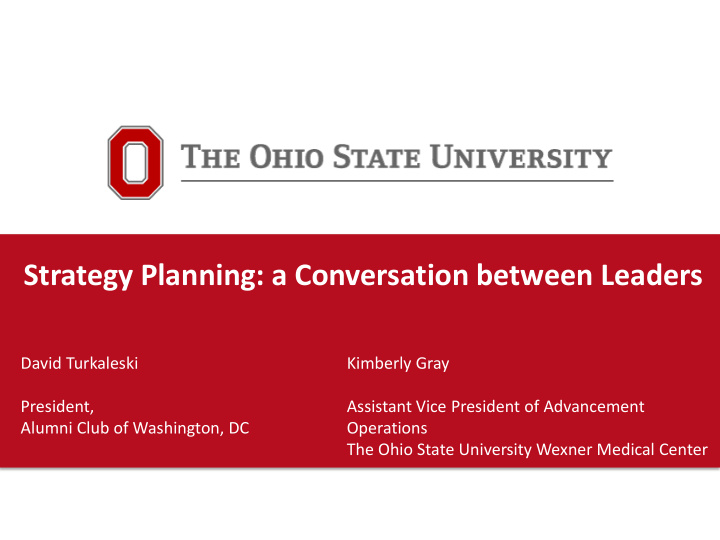



Strategy Planning: a Conversation between Leaders David Turkaleski Kimberly Gray President, Assistant Vice President of Advancement Alumni Club of Washington, DC Operations The Ohio State University Wexner Medical Center
Strategy without tactics is the slowest route to victory, tactics without strategy is the noise before defeat. ” Sun Tsu, Ancient Chinese Military strategist 2
What is Necessary for Strategy Planning? 3
OSUAA STRATEGIES – from 2017 Strategic Plan 1. Engage an increasing number of alumni in mutually beneficial, personal relationships with the university and each other. 2. Communicate with alumni innovatively and effectively to enhance alumni engagement and connection with the university. 3. Enhance career and leadership development services so Buckeyes can be the best that they can be at whatever they do. Cultivate a culture of philanthropy that connects the passions of alumni and friends with Ohio State ’ s 4. efforts to educate students, solve problems, and transform the world. 5. Partner with colleges, units, and regional campuses to enhance student and alumni development, engagement, and connection with the university. Strengthen the Association ’ s commitment to its culture, volunteers, and staff through initiatives focused 6. on diversity and leadership development. 7. Manage all Association resources thoughtfully, intentionally, and inventively to increase operational efficiency and effectiveness across the organization. 4
Case Study 5
Why did we create a strategic plan? 1. To develop a unified mission AND vision for OSUDC. 2. Determine our priorities. 3. Establish long term goals. 4. Add in board member transitions & recruitment. 5. Volunteer recruitment. 6. Transition from a tactical board to a strategic board. 6
How did we create a strategic plan? Phase 1: Present to the board why a strategic plan is needed. • This creates board member alignment, buy in and ownership. Phase 2: Who is going to facilitate? • Internal vs external facilitator. • An external facilitator is recommended. • Avoids personal bias, pushing of ideas and individual dynamics. Phase 3: President & facilitator design offsite strategy meeting. • Worked with the facilitator to design the structure of the meeting. Phase 4: Meeting • Office space / conference room to avoid distractions. • President should not dominate the discussion. • Allow the board to develop the mission, vision and goals. Phase 5: Implementation 7
Star and PRoMPT Models Realignment Leadership of Change Alignment The way we need to be tomorrow How the Leadership Team Makes it Happen The way we are today 8
Star Models – Strategy Today Star People Structure Information/ Rewards Decision Processes 9
PRoMPT Models 10
Star Models – Strategy Tomorrow Star People Structure Information/ Rewards Decision Processes 11
Questions? Kim Gray – gray.722@osu.edu David Turkaleski – president@osudc.org 12
Recommend
More recommend